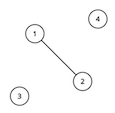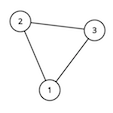Hongcow is ruler of the world. As ruler of the world, he wants to make it easier for people to travel by road within their own countries.
The world can be modeled as an undirected graph with n nodes and m edges. k of the nodes are home to the governments of the kcountries that make up the world.
There is at most one edge connecting any two nodes and no edge connects a node to itself. Furthermore, for any two nodes corresponding to governments, there is no path between those two nodes. Any graph that satisfies all of these conditions is stable.
Hongcow wants to add as many edges as possible to the graph while keeping it stable. Determine the maximum number of edges Hongcow can add.
The first line of input will contain three integers n, m and k (1 ≤ n ≤ 1 000, 0 ≤ m ≤ 100 000, 1 ≤ k ≤ n) — the number of vertices and edges in the graph, and the number of vertices that are homes of the government.
The next line of input will contain k integers c1, c2, ..., ck (1 ≤ ci ≤ n). These integers will be pairwise distinct and denote the nodes that are home to the governments in this world.
The following m lines of input will contain two integers ui and vi (1 ≤ ui, vi ≤ n). This denotes an undirected edge between nodes ui andvi.
It is guaranteed that the graph described by the input is stable.
Output a single integer, the maximum number of edges Hongcow can add to the graph while keeping it stable.
4 1 2 1 3 1 2
2
3 3 1 2 1 2 1 3 2 3
0
For the first sample test, the graph looks like this:

For the second sample test, the graph looks like this:

Source
Codeforces Round #385 (Div. 2)
My Solution
题意:有n个点(其中有k个关键点),m条边,要求添加尽量多的边使得k个关键点之间没有路径,问最多可以添加多少条边。
并查集+贪心+组合学、图论、dfs
用并查集处理这个图,相干联的点构成1颗树,然后把每棵树的结点数贮存在该树的根节点上,
然后开始贪心,找出k个关键点里,关键点所在树的结点个数最多的结点 maxci,
然后把这个ci 和它所关联的点 与 所有无关键点出现的树相结合(free),构成1个连通块,这个连通块的总边数是 (free + maxcnt) * (free + maxcnt - 1) / 2;
然后剩下的是除这个maxci以外的有关键点的树,这些树贮存的点构成完全图的边数是 if(i != maxci) ans += cnt[_find(c[i])] * (cnt[_find(c[i])] - 1) / 2;
所有得到的ans 是满足条件时的图的总边数,减点输入的m条边, ans - m 即为在公道的情况下可以添加的最大边数
复杂度 O(n^2)
#include <iostream>
#include <cstdio>
#include <cstring>
using namespace std;
typedef long long LL;
const int maxn = 1e3 + 8;
//有时可能需要 并查集+离散化
int father[maxn], _rank[maxn];
inline void DisjointSet(int n)
{
for(int i = 0; i <= n; i++){
father[i] = i;
}
}
inline int _find(int v)
{
return father[v] = father[v] == v ? v : _find(father[v]);
//同时紧缩路径,有时不能紧缩路径,有时必须紧缩路径,看具体情况
}
inline void _merge(int x, int y)
{
int a = _find(x), b = _find(y); //
if(_rank[a] < _rank[b]){
father[a] = b;
}
else{
father[b] = a;
if(_rank[a] == _rank[b]){
_rank[a]++;
}
}
}
LL c[maxn], cnt[maxn], maxci;
bool flag[maxn];
int main()
{
#ifdef LOCAL
freopen("d.txt", "r", stdin);
//freopen("d.out", "w", stdout);
int T = 4;
while(T--){
#endif // LOCAL
ios::sync_with_stdio(false); cin.tie(0);
int n, m, k, u, v;
cin >> n >> m >> k;
for(int i = 0; i < k; i++){
cin >> c[i];
}
DisjointSet(n);
for(int i = 0; i < m; i++){
cin >> u >> v;
if(_find(u) != _find(v)) _merge(u, v);
}
for(int i = 1; i <= n; i++){
cnt[_find(i)]++;
}
LL maxcnt = 0;
for(int i = 0; i < k; i++){
if(maxcnt < cnt[_find(c[i])]){
maxcnt = cnt[_find(c[i])];
maxci = i;
}
flag[_find(c[i])] = true;
}
LL free = 0;
for(int i = 1; i <= n; i++){
if(!flag[i]){
free += cnt[i];
}
}
LL ans = (free + maxcnt) * (free + maxcnt - 1) / 2;
for(int i = 0; i < k; i++){
if(i != maxci){
ans += cnt[_find(c[i])] * (cnt[_find(c[i])] - 1) / 2;
}
}
cout << ans - m << endl;
#ifdef LOCAL
memset(flag, false, sizeof flag);
memset(cnt, 0, sizeof cnt);
cout << endl;
}
#endif // LOCAL
return 0;
}
Thank you!
------from ProLights
